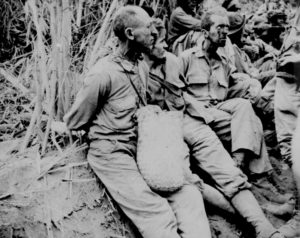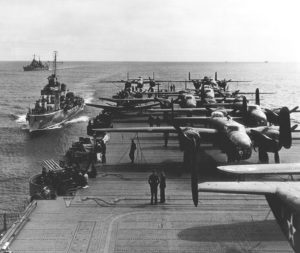Each year on November 11, leaders of the Veterans Memorial Building in Danville observe Veteran’s Day with various military exhibits and educational activities. The goal is to bridge the divide between past generations and future ones, passing along knowledge from lessons learned, sometimes at a bitter cost. Too often, our current educational system provides a brief review of a famous incident or two within a war era, and then moves on. There is little critical thinking developed from this; awareness that would help shape informed opinions for our future voting citizens and community leaders.
In addition to the great array of military equipment and informational displays, there will be two special topics of focus this year, with supporting exhibits and talks. Both will delve into the concept of citizens who take great risks and/or make extreme sacrifices to help gain freedom for their countries.
The first speaker, Cecilia Gaerlan, will discuss World War II events in the Philippines, with a special focus on the infamous Bataan Death March. Cecilia is the founder and Executive Director of the Bataan Legacy Historical Society. Its mission is to educate the public on the historical significance of Bataan and the impact of World War II in the Philippines. She was inspired by her father, Luis Gaerlan, Jr., a survivor of the Bataan Death March. The Society has developed addition high school course curriculum designed to improve student awareness of the war in the Philippines.
Many Americans are unaware that only hours after Pearl Harbor was attacked by the Japanese on December 7, 1941, our military bases were struck in the Philippines. Within days, the Philippine Islands were invaded by a determined and vicious Imperial Japanese Army. Their goal was to capture and enslave the island quickly, paving the way for conquering all of southeast Asia to create a Greater East Asia Co-Prosperity Sphere (the Japanese version of Hitler’s Third Reich).The fundamental key to their success was a speedy conquest, keeping the US and other allied countries off-balance and unable to respond, until they achieved a position of unassailable dominance. Their plan allocated 50 days for the conquest of the main island of Luzon and capture of the capital city Manila.
But the brave U.S. Army Forces in the Far East, the majority of whom were FiIipinos, would have none of this. Out-numbered, out-gunned, deprived of food, fuel and ammunition, and with no air support, they slowed the Japanese advance to a crawl. A peace time army with antiquated weapons, they knew for a fact they could not beat the Japanese Army. But they fought to give the allies time to get more organized in the Pacific and bring in more resources to stop the Japanese advance. Finally, after months of bitter struggle, the Bataan peninsula fell in April, 1942. This was double the amount of time the original invasion plan called for.
The Japanese rounded up an estimated 75,000 captives. They were forced to march 65 miles, in triple digit temperature with 100% humidity, to a prison known as Camp O’Donnell. There were no provisions for food, water, shelter or medicine during this 5-day trek. Those who couldn’t continue the march were beaten, bayoneted, shot, some were even beheaded. Up to 10,000 Filipinos and 650 American troops died along the way, which is why it is called the Bataan Death March.
 Once inside Camp O’Donnell, another 20,000 Filipinos and 1,600 Americans died from disease and starvation. Many others were sent on cramped hell ships to slave labor encampments in Japan and Manchuria for the duration of the war.This was a steep price to pay – but they bought enough time to save Australia and New Zealand from invasion. This provided the US and its allies a secure base in Southeast Asia from which to start pushing the Japanese back.
Once inside Camp O’Donnell, another 20,000 Filipinos and 1,600 Americans died from disease and starvation. Many others were sent on cramped hell ships to slave labor encampments in Japan and Manchuria for the duration of the war.This was a steep price to pay – but they bought enough time to save Australia and New Zealand from invasion. This provided the US and its allies a secure base in Southeast Asia from which to start pushing the Japanese back.
As the Bataan Death March was underway in the Philippines, some American “payback” for Pearl Harbor was on its way to the Japanese Home Islands roughly 2,000 miles to the north.
Bob Fish will then discuss the Doolittle Tokyo Raid, arguably the most legendary air raid in US military history, and its effect on the war. Bob, a long-time resident of Danville, is a Trustee with the USS Hornet Museum in Alameda and has written several articles about the Doolittle Raid. He was instrumental in helping the Raiders be nationally recognized with the Congressional Gold Medal in 2015.
Immediately after the Pearl Harbor surprise attack, President Roosevelt challenged his Chiefs of Staff to retaliate against the capital city of Tokyo. He knew this would do little material damage but the psychological aspect was enormous, both to the allies and the Japanese.
The US Navy could not handle the mission by themselves as their aircraft had a very limited flight range, which would imperil what was left of the Pacific fleet. The US Army Air Forces could not handle the mission because they had no bases left in China or the Philippines from which to launch a long range raid. In a moment of inspiration, Navy officers approached the Army Air Forces and said why don’t we launch Army bombers from a floating airfield in the Pacific Ocean, i.e. a Navy aircraft carrier?
The commander of the AAF agreed and turned the Army’s part of the effort over to his best aviator, Lt. Col. Jimmy Doolittle.
The twin engine B-25 Mitchell bomber was selected as being ideal for such a daring and hazardous undertaking. The mission profile required the aircraft to take off in the short distance of a carrier flight deck, fly 500 miles to Tokyo at a very low level over open ocean, drop the bombs and then fly on another 1,250 miles to China because it could not land back on the carrier.
On February 2, 1942, there was a single test to see if Army bombers could actually take off from an aircraft carrier. Two B-25s were launched from the USS Hornet (CV-8) off the Virginia coast. Based on that success, Doolittle had 24 aircraft modified appropriately, mostly with expanded fuel capacity. He then sought out USAAF volunteer pilots and crewmen, telling them only they would fly a “secret mission that was highly dangerous.” There was no shortage of volunteers!
They only had a few weeks to train in Florida, learning how to do a carrier-type launch of the B-25 (full throttle, full flaps, and lots of prayer). In late March, they flew to California where 16 of the aircraft were craned aboard the USS Hornet (CV-8) at Alameda Naval Air Station. Once the Army personnel were onboard, the ship and its escort vessels steamed out of San Francisco Bay, with the Golden Gate Bridge being their last sight of the homeland.
A week later, in the middle of the Pacific Ocean, they rendezvoused with another US Navy task force commanded by VADM Bill Halsey aboard the USS Enterprise (CV-6). They steamed together until reaching a point 650 miles east of Tokyo when they were discovered by Japanese picket boats. It was decided to launch the raid immediately, even though it was 150 miles further away than planned. All 80 USAAF fliers had serious doubts about having enough fuel to reach China.
But launch they did, starting at 8am, and in a storm with high winds and large waves, whose crests were coming over the bow. All 16 bombers got off safely in just an hour and most flew separately on their way to the island of Honshu.
Once they completed this air strike, they flew on to China. The airfield where they were supposed to land was unprepared for their arrival. Hence, each bomber eventually ran out of fuel that rainy night. Most aircrews bailed out, landing in rice paddies and on mountain tops. A few had to ditch along the seacoast. Three men died during this end-of-flight period and eight were captured by the Japanese (three were executed and one other died in captivity). Within weeks, sixty nine of the eighty crewmen eventually made their way out of China and back into the US war effort.
All of these young men volunteered for what was essentially a suicide mission. Only due to a timely tail wind did they reach the Chinese coast. But the sacrifice they made, and the risks they took, had a significant impact on the war effort. American and Allied morale was boosted while the Japanese were shocked they could be attacked so easily. Only 6 weeks later, the Japanese launched a hastily prepared attack on Midway Island to prevent further air raids on their home islands. It was a disastrous defeat for them, shortening the war by years. The sacrifices of 80 volunteers provided immeasurable benefit in keeping the US, the arsenal of democracy, alive and well, ending in defeat of the Axis powers.
The Veteran’s Day activities will take place in the Veterans Memorial Building at 400 Hartz Avenue in downtown Danville on November 10, 11, and 12. The public presentations will be at 2pm on Saturday. More information is available at www.vmbsrv.org.
Leave a Reply